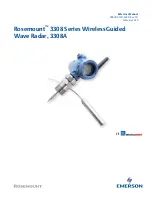
Operating Manual 6175.4760.02 – 01
5.37
M3SR Series 4100
IP over Air (IPoA)
the retransmission timer for that packet will be increased by a certain factor (TCP back-off).
The transmission window will be opened very slowly after the reduction to avoid another con-
gestion.
This behaviour can cause some negative effects if TCP/IP connections are transmitted via
radio links. If packets are lost because of a brief jamming or an interrupted link (shadow ef-
fects) and (shortly) after that the link is error- free again, TCP will accidentally assume a con-
gestion and will react with the mechanisms described above. Also, if the link is available
again, no data will be sent because TCP is in back-off and/or has reduced its transmission
window (Comment: How the transmission window is used and whether the data transmission
is completely blocked by e.g. the only pending TCP packet which waits to be retransmitted
depends strongly on the application protocol which is used over TCP/IP!).
The disadvantages using TCP/IP over erroneous/slow radio channels arise from these ef-
fects and it is recommended to use UDP as transport protocol.
All above mentioned drawbacks cause a massive performance degradation when multiple
TCP connections are running over the air network. In the worst case, it is even possible that
some TCP connections time out. IPoA provides a solution called FastLink in order to handle
multiple TCP connections (or other IP protocol based connections) efficiently. Please refer
to sect. 5.3.2 FastLink Mode (FLM) for information regarding FastLink.
Recommended Adjustments for TCP
If TCP is the only available means to be used as transport protocol, some settings on the
host-side can positively influence the behaviour of TCP over the radio channel.
The following settings are recommended in order to enhance TCP performance:
•
Enabling Selective Acknowledgments (SACK)
If SACK is activated, only lost packets must be retransmitted, and not those which were
sent afterwards.
•
Enabling timestamps
Adding a timestamp in the TCP options field helps to calculate the RTT more accurately
which in turn results in precise timeouts and thus optimizes retransmission handling.
•
Disable window scaling
Make sure the window scaling option is disabled, some operating systems like Windows
Vista have this option enabled per default.
•
Non-delayed ACKs
The TCP implementation of Microsoft Windows delays per default all ACKs by 200 ms
in order to minimize overhead (possibility to acknowledge more than one packet at once
if packets arrive within 200 ms). However, for radio links it is better to avoid an ACK delay
in order to keep the RTT as low as possible.
•
Maximum Transmission Unit (MTU) of 512 bytes
A smaller MTU reduces the risk of packet corruption due to fluctuating radio channel
quality and optimizes throughput for concurrent connections.
Содержание M3SR 4100 Series
Страница 15: ...M3SR Series 4100 Documentation Overview xiv Operating Manual 6175 4760 02 01...
Страница 48: ...M3SR Series 4100 Index 34 Operating Manual 6175 4760 02 01 ZF4401 mod 02 2 10...
Страница 70: ...M3SR Series 4100 Radio Control 1 22 Operating Manual 6175 4760 02 01...
Страница 116: ...M3SR Series 4100 Example Configuration 2 46 Operating Manual 6175 4760 02 01...
Страница 336: ...M3SR Series 4100 Priority Channel 3 220 Operating Manual 6175 4760 02 01...
Страница 546: ...M3SR Series 4100 Further Settings are Relevant for SECOM H Operation 4 210 Operating Manual 6175 4760 02 01...
Страница 696: ...M3SR Series 4100 Remote Control 8 4 Operating Manual 6175 4760 02 01...
Страница 697: ...Operating Manual 6175 4760 02 01 9 1 M3SR Series 4100 Drawings 9 Drawings...
Страница 706: ...M3SR Series 4100 Drawings 9 10 Operating Manual 6175 4760 02 01...
















































